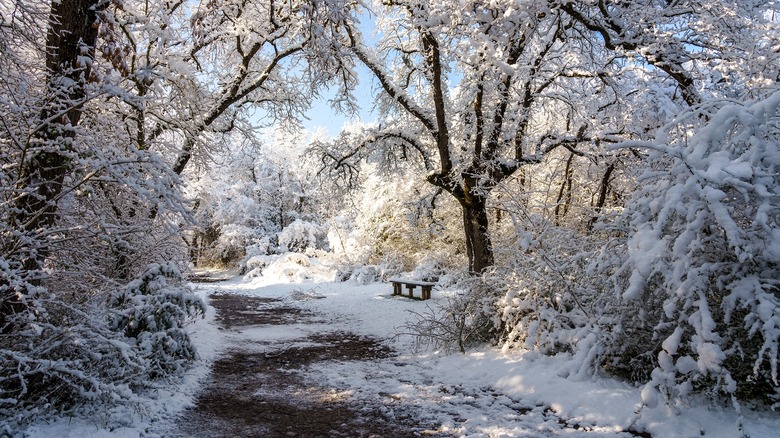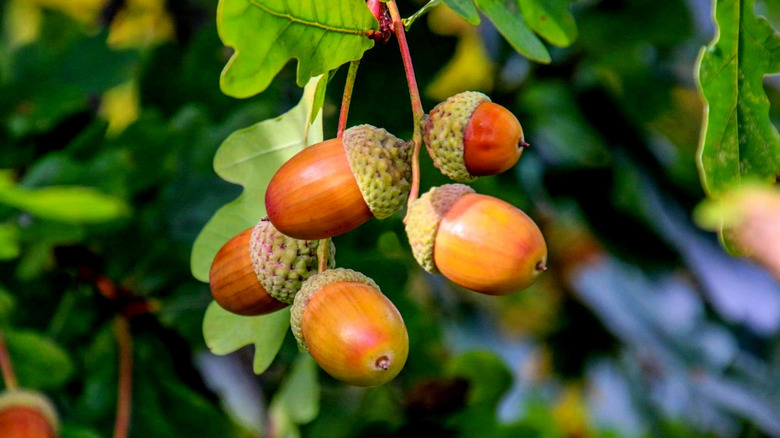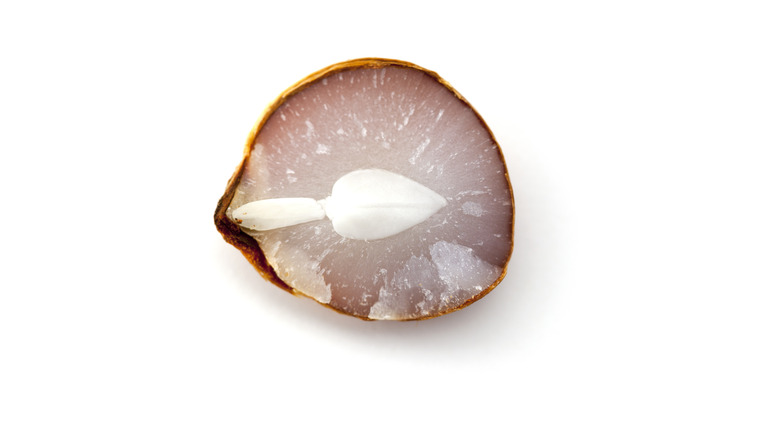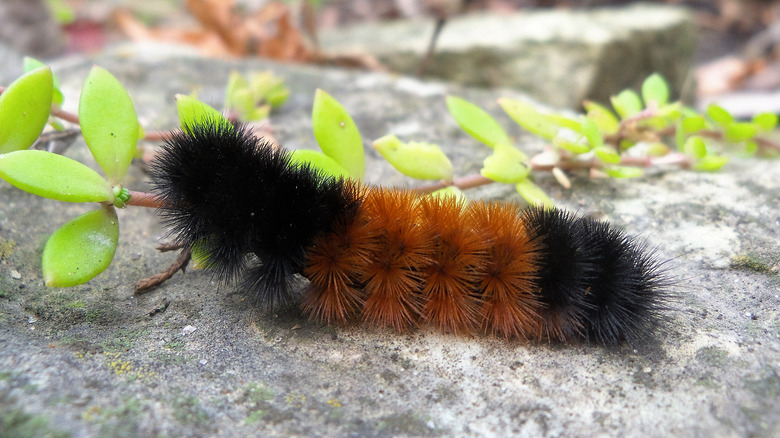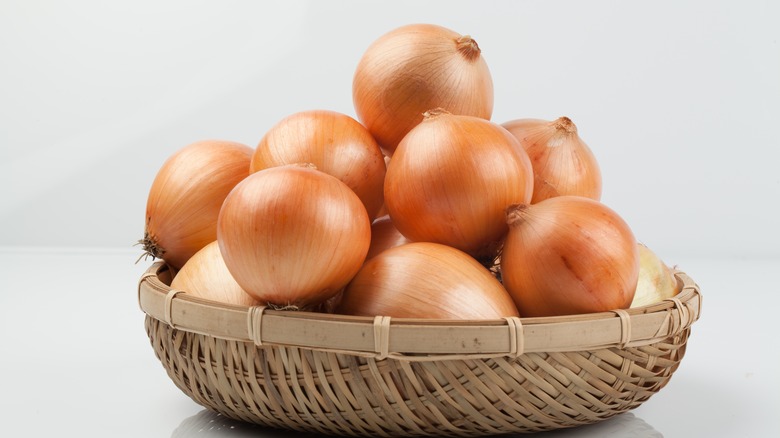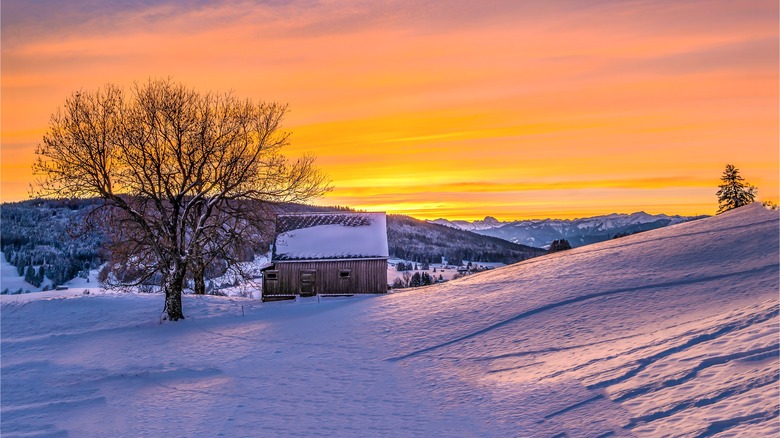Weather Folklore That Is Said To Predict Your Winter Forecast
Over the past century or so, humans have gotten considerably better at predicting the weather, both in the short term and in the long term. For example, we can predict hurricanes days before they make landfall and warn those in their path to evacuate. Similarly, thanks to computer modeling, you likely have an app on your phone that can predict the weather in your location up to 14 days in advance (although the technology is far from foolproof).
Determining long-term trends is a bit trickier, however. Scientists can point to a few key indicators, such as an El Niño and La Niña system, that suggest general trends — such as generally wetter or drier, or generally warmer or colder — but in the main, it's all just educated guesswork. Further still, such forecasts cover whole regions and aren't going to be much good for telling you just how severe the winter is going to be in, say, Detroit or El Paso.
However, science is one thing, folklore is another. And for centuries, humans have been pointing to natural occurrences, such as the number of acorns that fall, that supposedly portend how severe winter is going to be.
Do Acorns Predict The Winter?
If you've ever had the fortune (or misfortune, depending on your point of view) to live near an oak tree, you know just how ubiquitous acorns can be. Not only are they tricky to blow away with a leaf blower, but if a branch hangs over your house, it can sound like a barrage of them when they fall on the roof on certain windy nights. Farmers' Almanac claims that "lots of acorns" can portend a "rough winter," but the outlet doesn't specify what's meant by "lots" or "rough." Similarly, ThoughtCo notes that a blanket of acorns predicts a blanket of snow and adds the animal that loves acorns the most — the squirrel — into the conversation. Specifically, the publication claims that squirrels that are "more active than usual" are a portent of a severe winter.
Science is here to throw a wet blanket on this belief, however. "There's no correlation between the amount of snowfall or the temperature with acorn production. So we don't have to worry about that one," says Roger Wrubel of Mass Audubon's Habitat and Education Center (via CBS News).
The Shape Of A Persimmon Seed
As ThoughtCo indicates, persimmons are edible roughly from October through February (and for the love of whatever deity you do or do not believe in, don't eat persimmons out of season — they're deadly!). The fall emergence of persimmons has also brought with it its own bit of folklore, complete with its own mnemonic: If you cut open a persimmon seed, the shape inside will predict the winter for you. A spoon-shaped pattern in the seed is indicative of a shovel and means you'll be shoveling a lot of snow; a knife indicates "cutting" winds; and a fork shape portends light, powdery snow.
There are a couple of caveats to this. First, make sure you're using a locally-grown persimmon for your prophecies; if you get one grown somewhere else, you're getting that region's forecast, not your own. And second, it's all nonsense anyway: The Old Farmer's Almanac is clear that cutting open persimmon seeds is just a "fun, unscientific way to come up with a winter forecast."
Caterpillar Markings
The insect you see above is variously known throughout the United States as the wooly bear caterpillar, or the wooly worm caterpillar. It's actually the larva of the Isabella tiger moth, according to ThoughtCo, and to hear some tell it, the thickness of the brown patch that surrounds the creature's mid-section is a forecast of winter. Specifically, a narrow orange/brown band indicates a severe winter, while a wider one suggests a milder one.
This one actually might have the tiniest kernel of scientific truth to it. Maybe. Specifically, back in the 1940s, entomologist Charles Curran of New York City's Museum of Natural History compared caterpillar color lengths to winter weather forecasts provided by a local newspaper and found that 80% of the time, the caterpillars and the newspaper gave the same forecast. However, repeatability of experiments and results is paramount in science, and later researchers haven't been able to replicate Curran's results.
Other Indicators
It's not just the acorn or persimmon that supposedly indicates what type of winter you'll have. As The Old Farmer's Almanac reports, the skins of various fruits and vegetables that you eat, including those of onions and apples (as well as corn husks), can foretell winter in one way or another. Specifically, thicker and tighter skins/husks can portend a harsher winter, according to folklore. Farmers' Almanac adds in a few other supposedly prophetic things from the plant kingdom — including thick bark on the north side of trees, thick hickory nut shells, and green leaves late into the autumn — that supposedly mean a harsh winter is on the way.
The animal kingdom also gives us more to look at than caterpillars. Raccoons with thick tails and bright bands supposedly indicate a bad winter, as do crickets in a chimney, pigs gathering sticks, and owls hooting late into the fall. According to The Old Farmer's Almanac, before Europeans arrived, some Native Americans believed that the thickness of a beaver's fur could be counted on to determine the severity of the upcoming winter.
Why Do People Believe This Stuff?
These days, scientific observations and reason rule the day — at least when it comes to the weather. No self-respecting TV weather reporter is going to consult some talisman to provide the forecast, but rather, they're going to look at data. Data provided by scientists with precise instruments whose literal job is to make sense of the data.
So why do people still hold on to seemingly-nonsensical myths from hundreds or even thousands of years ago when it comes to predicting the weather? As Farmers' Almanac's Sandi Duncan notes, there was a time in history when science and the weather were miles apart, and people made do with what they observed. And if they observed a higher-than-normal number of acorns (or thicker-than-normal onion husks, or whatever) followed by a harsh winter, then in their minds, at least, a relationship was established. Hand it down over and over again, generation after generation, and these types of things can stick.
There's also the matter that oral history can change with the telling. Duncan compares it to a game of telephone, where a message gets diluted and even wholly changed when it's repeated from person to person over multiple retellings. In other words, the lore that some people believe when it comes to prophesying the severity of the winter may not even be the same lore that their ancestors believed.
